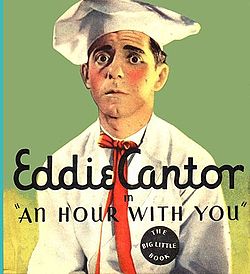- The Chase and Sanborn Hour
-
The Chase and Sanborn Hour was the umbrella title for a series of US comedy and variety radio shows, sponsored by Standard Brands' Chase and Sanborn Coffee, usually airing Sundays on NBC from 8pm to 9pm during the years 1929 to 1948.
The series began in 1929 as The Chase and Sanborn Choral Orchestra, a half-hour musical variety show heard Sundays at 8:30pm on NBC. When Maurice Chevalier became the show's star, he received a record-breaking salary of $5000 a week. Violinist David Rubinoff (September 13, 1897 – October 06, 1986), became a regular in January 1931, introduced as "Rubinoff and His Violin."
With Chevalier returning to Paris, Eddie Cantor was chosen as his replacement and the new 60-minute program, The Chase and Sanborn Hour, was launched September 13, 1931, teaming Cantor with Rubinoff and announcer Jimmy Wallington. The show established Cantor as a leading comedian, and his scriptwriter, David Freedman, as “the Captain of Comedy.” When Jimmy Durante stepped in as a substitute for Cantor, making his first appearance on September 10, 1933, he was so successful that he was offered his own show. Then the world's highest paid radio star, Cantor continued as The Chase and Sanborn Hour's headliner until November 25, 1934.
With a new format, The Opera Guild, hosted by Deems Taylor, began December 2, 1934, Sundays at 8pm, on The Chase and Sanborn Hour, and that concert series continued until March 17, 1935. Major Bowes' Amateur Hour had the slot from March 24, 1935 until September 11, 1936, followed by Do You Want to Be an Actor?, with Haven MacQuarrie, broadcast from January 3, 1937 until May 2, 1937, a series that continued Sundays at 10:30pm as a half-hour show from December 5, 1937 until February 20, 1938.
Edgar Bergen
Meanwhile, Chase and Sanborn found a gold mine with a wooden dummy when Edgar Bergen and Charlie McCarthy began an 11-year run, starting May 9, 1937. Initially this incarnation of the program also featured as regulars master of ceremonies Don Ameche, singers Dorothy Lamour and Nelson Eddy, and (for the first few weeks) comedian W.C. Fields, accompanied by a different guest star each week. Perhaps the most infamous of the latter was Mae West, whose appearance on the program of December 12, 1937 was highlighted with a sexually suggestive "Adam and Eve" sketch that caused a public outcry and resulted in West being banned from the radio airwaves for many years thereafter.
Beginning January 7, 1940, the regular cast apart from Bergen and McCarthy were dropped and the show was cut to a half-hour and retitled The Chase and Sanborn Program. Also beginning in 1940, the program would go on hiatus for a number of weeks each summer. CBS would fill its airtime with a different substitute show each year; these included The Bishop and the Gargoyle (1940), What's My Line? (1941), Star-Spangled Vaudeville (1942), Paul Whiteman Presents (1943), The Gracie Fields Show (1944), The Frances Langford Show (1945), and Alec Templeton Time (1946-47). In the fall of 1948 Chase and Sanborn announced that it would terminate its contract with Edgar Bergen at the end of the year. The remaining Bergen/McCarthy programs eschewed guest stars in favor of regular sketches featuring Don Ameche and Marsha Hunt as The Bickersons. In 1949 Bergen went to CBS, with a new weekly program (The Charlie McCarthy Show) sponsored by Coca-Cola.
Although the series ended December 26, 1948, it was followed by a compilation show on NBC, The Chase and Sanborn 100th Anniversary Show (November 15, 1964), assembled by writer Carroll Carroll and narrated by Bergen. This became an annual event with The Chase and Sanborn 101st Anniversary Show (November 14, 1965), a Fred Allen tribute, followed by The Chase and Sanborn 102nd Anniversary Show (November 13, 1966), which turned out to be the last of the series.
Listen to
- The Chase and Sanborn Hour with Eddie Cantor (excerpts)
- OTR Network Library: The Chase and Sanborn Hour (six 1937-46 episodes)
- W.C. Fields, Edgar Bergen and Charlie McCarthy's first show for the Chase And Sanborn Hour 1937-05-09 (01) Guest - Ann Harding - with a new introduction
External links
Categories:- American variety radio programs
- Old-time radio programs
- 1920s American radio programs
- 1930s American radio programs
- 1940s American radio programs
Wikimedia Foundation. 2010.

